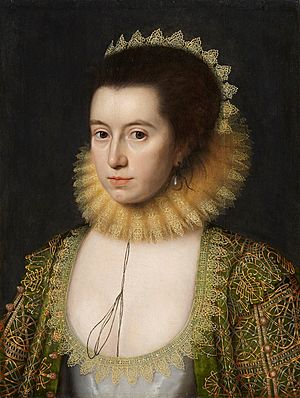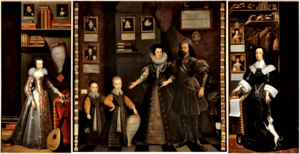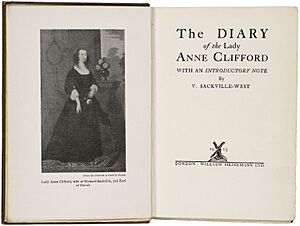Lady Anne Clifford facts for kids
Quick facts for kids
Lady Anne Clifford
|
|
|---|---|

Lady Anne Clifford, portrait by William Larkin, National Portrait Gallery, London
|
|
| Born | 30 January 1590 Skipton Castle, England |
| Died | 22 March 1676 (aged 86) |
| Noble family | Clifford |
| Spouse(s) |
Richard Sackville, 3rd Earl of Dorset
(m. 1609; died 1624) |
| Issue |
|
| Father | George Clifford, 3rd Earl of Cumberland |
| Mother | Lady Margaret Russell |
Lady Anne Clifford (born January 30, 1590 – died March 22, 1676) was an important English noblewoman. She was known for her strong will and her efforts to get back her family's lands. Anne became the 14th Baroness de Clifford in her own right in 1605.
She loved books and writing, keeping a diary and writing many letters. Anne also held the special job of High Sheriff of Westmorland from 1653 to 1676. She spent much of her later life restoring her family's old castles.
Contents
Her Early Life and Family
Lady Anne was born on January 30, 1590, at Skipton Castle in Yorkshire, England. She was the only child of George Clifford, 3rd Earl of Cumberland and Lady Margaret Russell. Her father was a famous adventurer and courtier.
Anne's parents had a difficult marriage and lived apart for much of her childhood. Her two older brothers died very young. This meant Anne was the only child left to inherit. She was mostly raised by her mother in a home with many women. The poet Samuel Daniel was her tutor, giving her an excellent education. As a child, she was a favorite of Queen Elizabeth I.
Life at Court
Anne was part of court life when she was young. She danced in special plays called masques with Queen Anne of Denmark, King James I's wife. She performed in masques by famous writers like Samuel Daniel and Ben Jonson.
Fighting for Her Inheritance
When her father died in 1605, Anne became the Baroness de Clifford. This was an old title that could be passed down to women. However, her father's other lands and his earldom went to his younger brother, Francis Clifford, 4th Earl of Cumberland. Her father only left her £15,000.
Anne believed she should have inherited the family estates. These lands were supposed to pass down to the oldest child, even if it was a girl. She was only 15 when her father died. She began a long and difficult legal fight to get these lands back.
It took many years, but in 1643, her cousin, Henry Clifford, 5th Earl of Cumberland, died without any sons. This meant Anne finally had a stronger claim to the family estates. She officially took control of them in 1649.
Her Marriages and Children
Lady Anne Clifford was married two times. Both marriages were quite challenging.
First Marriage
On February 27, 1609, Anne married Richard Sackville, 3rd Earl of Dorset. His grandfather helped arrange the marriage. Richard was a well-known figure at court.
Anne and Richard had five children, but three sons died young. Their two daughters were:
- Lady Margaret Sackville (1614–1676): She married John Tufton, 2nd Earl of Thanet. The Baron de Clifford title later passed through her family.
- Lady Isabella Sackville (1622–1661): She married James Compton, 3rd Earl of Northampton.
Anne and Richard often disagreed, especially about her fight for her inheritance. Richard wanted her to give up the legal battle, but Anne refused. This was unusual for women at the time, who were expected to obey their husbands.
Second Marriage
In 1630, Anne married Philip Herbert, 4th Earl of Pembroke and 1st Earl of Montgomery. He was a powerful nobleman.
Her second marriage also had its difficulties. One major disagreement was about her younger daughter's choice of husband. Anne insisted on letting her daughter choose, which was against her husband's wishes.
A Supporter of the Arts
Lady Anne was a very important supporter of literature and writers. She was also a writer herself. She kept a detailed diary from 1603 to 1616. She also wrote many letters. People said she could talk about almost anything.
She had a huge painting made called The Great Picture. It shows her at three different ages: as a baby in her mother's womb, as a 15-year-old girl, and as a 56-year-old woman. This painting is now in the Abbot Hall Art Gallery in Kendal, Cumbria.
Restoring Castles and Buildings
After gaining her family's estates, Lady Anne became a very rich landowner. She spent much of her later life improving and rebuilding her family's castles. These included Skipton Castle in Yorkshire and Pendragon Castle, Brough Castle, Appleby Castle, and Brougham Castle in Westmorland (now Cumbria).
In 1656, she built the Countess Pillar near Brougham, Cumbria. This monument honors her mother and marks the last place they met. Every year on April 2, money is given to the poor there.
She also helped restore churches in places like Appleby-in-Westmorland, Ninekirks, Brougham, and Mallerstang.
Later Life and Legacy
Lady Anne was very involved with her tenants and managed her lands carefully. She made sure rents were paid and even took people to court if needed. She moved between her different castles, living in each for several months at a time.
She died at the age of 86 on March 22, 1676, at Brougham Castle. She passed away in the same room where her father was born and her mother died. Her tomb is in St Lawrence's Church in Appleby-in-Westmorland.
Lady Anne Clifford is remembered as a strong, independent woman who fought for her rights and preserved her family's heritage.
See also
 In Spanish: Anne Clifford para niños
In Spanish: Anne Clifford para niños



